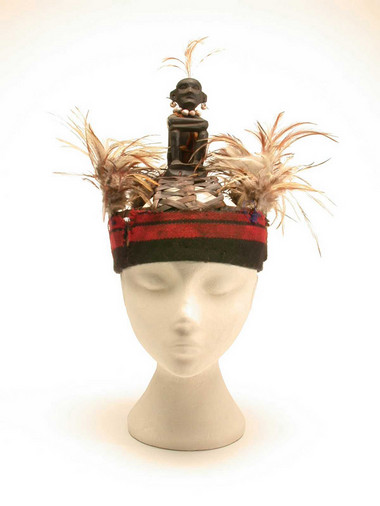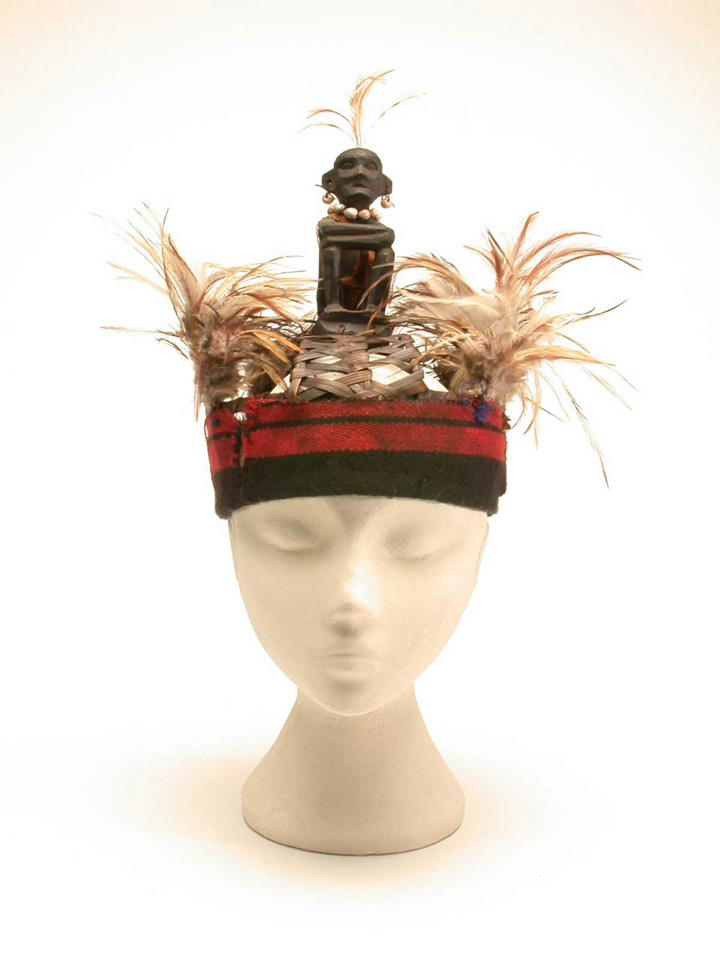Headdress, Ifugao Tribe, Philippines
This head-dress comes from the Ifugao people in Luzon, northern Philippines. Its woven frame is decorated with feathers and seated on top is a wooden figure - the rice god Bul-ul. Bul-ul brings good luck to the harvest and the village chief would probably wear this crown during planting and harvest rituals.
The figure wears a band of yellow and red woven cloth. Seed earrings dangle from the ears and a seed necklace adorns the neck. A spray of feathers shoots out the top of the head.
The Ifugao women are known for their weaving crafts and basketry, while the men are skilled wood carvers and metal workers. This crown has both weaving and woodcarving, so we know that both women and men worked on it. The frame has been woven from grass, and a cloth headband reinforces the frame at the front. The older members of the village carve Bul-ul figures. For special ceremonies a senior priest carves the Bul-ul from sacred wood of a chosen narra tree. The ritual carving involves making animal sacrifices to the Bul-ul.
The figure wears a band of yellow and red woven cloth. Seed earrings dangle from the ears and a seed necklace adorns the neck. A spray of feathers shoots out the top of the head.
The Ifugao women are known for their weaving crafts and basketry, while the men are skilled wood carvers and metal workers. This crown has both weaving and woodcarving, so we know that both women and men worked on it. The frame has been woven from grass, and a cloth headband reinforces the frame at the front. The older members of the village carve Bul-ul figures. For special ceremonies a senior priest carves the Bul-ul from sacred wood of a chosen narra tree. The ritual carving involves making animal sacrifices to the Bul-ul.

The Ifugao people in Luzon, one of the islands of the Philippines, are known as the 'people of the earth' because they carve magnificent terraces from the mountains and grow rice on them. Rice growing is very important to the Ifugao people - it is their main source of income. The success of a harvest means the difference between a year of plenty and a year of starvation.
Consequently, the Ifuago have many rituals and ceremonies to ensure a good rice harvest. At the beginning of the planting season the men of the village consult the omens to check if it is the right time to begin. They visit a sacred place and check for favourable signs, like a birdcall. Then they take part in a sham fight followed by group dancing and singing. Animal sacrifices to appease the gods are very important and pigs, chickens or dogs are killed at the foot of sacred trees. If all the omens are good the planting can begin and a woman chosen by the village chief will sow the first of the crop.
There are similar ceremonies when it comes to harvest time. When the time is auspicious the village chief gathers in the first rice crop and at the end of the harvest the village celebrates with a two-day feast. It is likely that the village chief would wear this headdress in leading the rice planting and harvesting ceremonies.
This rice god Bul-ul is associated with the rituals surrounding rice cultivation. Sacrifices are made to gain favour with the Bul-ul prior to planting. After gathering in the harvest the figures are placed in a granary house or attic where they are believed to make the rice grains multiply and guard the crop from vermin or thieves. During the harvest feasting, the Bul-ul are brought out to share the bounty of the harvest. There are over 1500 gods in the Ifugao religion and there is a specific god for every aspect of life - one for the welfare of animals, one for war, one for property etc. The Bul-ul is a key deity which features widely in peace and healing rituals, and statues of him appear throughout the Ifuago culture.
The crown was originally thought to be a headhunter's head-dress, but as it dates from the 20th century, this is unlikely. By then, headhunting had long ceased. In the thousand years before the Spanish took control of the Philippines in the 16th Century, headhunting was part of tribal culture and went on between warring neighbouring tribes. The Ifuago were particularly known for their headhunting prowess and they would return from forays into enemy territory with the heads of their victims. During the rice-planting rituals, the sham fights hark back to the old headhunting days.
Consequently, the Ifuago have many rituals and ceremonies to ensure a good rice harvest. At the beginning of the planting season the men of the village consult the omens to check if it is the right time to begin. They visit a sacred place and check for favourable signs, like a birdcall. Then they take part in a sham fight followed by group dancing and singing. Animal sacrifices to appease the gods are very important and pigs, chickens or dogs are killed at the foot of sacred trees. If all the omens are good the planting can begin and a woman chosen by the village chief will sow the first of the crop.
There are similar ceremonies when it comes to harvest time. When the time is auspicious the village chief gathers in the first rice crop and at the end of the harvest the village celebrates with a two-day feast. It is likely that the village chief would wear this headdress in leading the rice planting and harvesting ceremonies.
This rice god Bul-ul is associated with the rituals surrounding rice cultivation. Sacrifices are made to gain favour with the Bul-ul prior to planting. After gathering in the harvest the figures are placed in a granary house or attic where they are believed to make the rice grains multiply and guard the crop from vermin or thieves. During the harvest feasting, the Bul-ul are brought out to share the bounty of the harvest. There are over 1500 gods in the Ifugao religion and there is a specific god for every aspect of life - one for the welfare of animals, one for war, one for property etc. The Bul-ul is a key deity which features widely in peace and healing rituals, and statues of him appear throughout the Ifuago culture.
The crown was originally thought to be a headhunter's head-dress, but as it dates from the 20th century, this is unlikely. By then, headhunting had long ceased. In the thousand years before the Spanish took control of the Philippines in the 16th Century, headhunting was part of tribal culture and went on between warring neighbouring tribes. The Ifuago were particularly known for their headhunting prowess and they would return from forays into enemy territory with the heads of their victims. During the rice-planting rituals, the sham fights hark back to the old headhunting days.


This head-dress comes from the Ifugao people in Luzon, northern Philippines. Its woven frame is decorated with feathers and seated on top is a wooden figure - the rice god Bul-ul. Bul-ul brings good luck to the harvest and the village chief would probably wear this crown during planting and harvest rituals.
The figure wears a band of yellow and red woven cloth. Seed earrings dangle from the ears and a seed necklace adorns the neck. A spray of feathers shoots out the top of the head.
The Ifugao women are known for their weaving crafts and basketry, while the men are skilled wood carvers and metal workers. This crown has both weaving and woodcarving, so we know that both women and men worked on it. The frame has been woven from grass, and a cloth headband reinforces the frame at the front. The older members of the village carve Bul-ul figures. For special ceremonies a senior priest carves the Bul-ul from sacred wood of a chosen narra tree. The ritual carving involves making animal sacrifices to the Bul-ul.
The figure wears a band of yellow and red woven cloth. Seed earrings dangle from the ears and a seed necklace adorns the neck. A spray of feathers shoots out the top of the head.
The Ifugao women are known for their weaving crafts and basketry, while the men are skilled wood carvers and metal workers. This crown has both weaving and woodcarving, so we know that both women and men worked on it. The frame has been woven from grass, and a cloth headband reinforces the frame at the front. The older members of the village carve Bul-ul figures. For special ceremonies a senior priest carves the Bul-ul from sacred wood of a chosen narra tree. The ritual carving involves making animal sacrifices to the Bul-ul.
- Term:
- Description:
- Bul-ul
- The rice god whom the Ifuago people of the Philippines invoke and make animal sacrifices to, in order to bring good luck to the harvest.
- Harvest
- A ripened crop; to gather in a ripened crop.
- Headhunting
- A practice among certain peoples of removing the heads of enemies they have killed and preserving them as trophies.
- Ifugao
- The people of the mountainous region of Luzon, who live in communities and grow rice as their main crop and source of income.
- Luzon
- The largest of the Philippine islands and is the location of the capital city, Manila. Luzon is home to the Ifugao who live in the mountainous region in the north of the island.
- Narra tree
- The national tree of the Philippines and the favourite timber for woodcarving and the manufacture of fine furniture. The wood is quite hard and heavy, easy to work with, pleasantly rose-scented, takes a fine polish, develops a range of rich colours from yellow to red and has conspicuous growth rings.
- Philippines
- A country in south-east Asia comprised of 7,107 islands between the Pacific Ocean and the South China Sea. The Philippines were named for King Philip II of Spain after the Spanish took control of the islands in 1565.
- Ritual
- A religious or traditional ceremony involving a series of fixed actions performed in a certain order.
- Sacrifices
- Sacrifice - the ritual killing of a person or an animal, as an offering to a god.




















